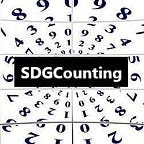SDG 11 Indicators- 2017 Updates
The updated list of SDG #11 Indicators since July 2016, with changes highlighted.
In summer 2016, we created a series of Medium stories listing the targets and indicators for the Sustainable Development Goals. Since then, meetings have been held that have altered and edited the global indicators framework. Here, we highlight the changes and additions that have been made since July 2016 up to April 2017, to update our indicator stories before the High Level Political Forum takes place in July 2017.
*Changes and additions to indicators are italicized, along with notes from the IAEG-SDGs as to the purpose of the edit. For Goal 11, changes begin at Target 11.5
SDG 11: Sustainable Cities and Communities — Indicators by Targets
Target 11.1. By 2030, ensure access for all to adequate, safe and affordable housing and basic services and upgrade slums
Indicator 11.1.1: Proportion of urban population living in slums, informal settlements, or inadequate housing
Target 11.2. By 2030, provide access to safe, affordable, accessible and sustainable transport systems for all, improving road safety, notably by expanding public transport, with special attention to the needs of those in vulnerable situations, women, children, persons with disabilities and older persons
Indicator 11.2.1: Proportion of population that has convenient access to public transport, by sex, age and persons with disabilities
Target 11.3. By 2030, enhance inclusive and sustainable urbanization and capacity for participatory, integrated and sustainable human settlement planning and management in all countries
Indicator 11.3.1: Ratio of land consumption rate to population growth rate
Indicator 11.3.2: Proportion of cities with a direct participation structure of civil society in urban planning and management that operate regularly and democratically
Tier 3, Fast Track; Reviewed at 5th IAEG-SDG meeting; Request finalized metadata and results of pilot studies
Target 11.4. Strengthen efforts to protect and safeguard the world’s cultural and natural heritage
Indicator 11.4.1: Total expenditure (public and private) per capita spent on the preservation, protection and conservation of all cultural and natural heritage, by type of heritage (cultural, natural, mixed and World Heritage Centre designation), level of government (national, regional and local/municipal), type of expenditure (operating expenditure/investment) and type of private funding (donations in kind, private nonprofit sector and sponsorship)
Target 11.5. By 2030, significantly reduce the number of deaths and the number of people affected and substantially decrease the direct economic losses relative to global gross domestic product caused by disasters, including water-related disasters, with a focus on protecting the poor and people in vulnerable situations
Indicator 11.5.1: Number of deaths, missing persons and directly affected persons attributed to disasters per 100,000 population
Previous Indicator: Number of deaths, missing persons and persons affected by disaster per 100,000 people
Sendai modification; Reviewed at 5th IAEG-SDG meeting
Repeat of 1.5.1 and 13.1.1
Indicator 11.5.2: Direct economic loss in relation to global GDP, damage to critical infrastructure and number of disruptions to basic services, attributed to disasters
Previous Indicator: Direct disaster economic loss in relation to global GDP, including disaster damage to critical infrastructure and disruption of basic services
Sendai modification; Reviewed at 5th IAEG-SDG meeting
Target 11.6. By 2030, reduce the adverse per capita environmental impact of cities, including by paying special attention to air quality and municipal and other waste management
Indicator 11.6.1: Proportion of urban solid waste regularly collected and with adequate final discharge out of total urban solid waste generated, by cities
Indicator 11.6.2: Annual mean levels of fine particulate matter (e.g. PM2.5 and PM10) in cities (population weighted)
Target 11.7. By 2030, provide universal access to safe, inclusive and accessible, green and public spaces, in particular for women and children, older persons and persons with disabilities
Indicator 11.7.1: Average share of the built-up area of cities that is open space for public use for all, by sex, age and persons with disabilities
Tier 3, Fast Track; Reviewed at 5th IAEG-SDG meeting; Request finalised methodology development and results of pilot studies
Indicator 11.7.2: Proportion of persons victim of physical or sexual harassment, by sex, age, disability status and place of occurrence, in the previous 12 months
Target 11.a. Support positive economic, social and environmental links between urban, per-urban and rural areas by strengthening national and regional development planning
Indicator 11.a.1: Proportion of population living in cities that implement urban and regional development plans integrating population projections and resource needs, by size of city
Target 11.b. By 2020, substantially increase the number of cities and human settlements adopting and implementing integrated policies and plans towards inclusion, resource efficiency, mitigation and adaptation to climate change, resilience to disasters, and develop and implement, in line with the Sendai Framework for Disaster Risk Reduction 2015–2030, holistic disaster risk management at all levels
Indicator 11.b.1: Number of countries that adopt and implement national disaster risk reduction strategies in line with the Sendai Framework for Disaster Risk Reduction 2015–2030
Previous Indicator: Proportion of local governments that adopt and implement local disaster risk reduction strategies in line with the Sendai Framework for Disaster Risk Reduction 2015–2030
Sendai modification; Reviewed at 5th IAEG-SDG meeting
Repeat of 1.5.3 and 13.1.2
Indicator 11.b.2: Proportion of local governments that adopt and implement local disaster risk reduction strategies in line with national disaster risk reduction strategies
Previous Indicator: Number of countries with national and local disaster risk reduction strategies
Sendai modification; Reviewed at 5th IAEG-SDG meeting
Repeat of 1.5.4 and 13.1.3
Target 11.c. Support least developed countries, including through financial and technical assistance, in building sustainable and resilient buildings utilizing local materials
Indicator 11.c.1: Proportion of financial support to the least developed countries that is allocated to the construction and retrofitting of sustainable, resilient and resource efficient buildings utilizing local materials
